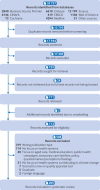Strategies and tactics to reduce the impact of healthcare on climate change: systematic review
- PMID: 39379104
- PMCID: PMC11459334
- DOI: 10.1136/bmj-2024-081284
Strategies and tactics to reduce the impact of healthcare on climate change: systematic review
Abstract
Objective: To review the international literature and assess the ways healthcare systems are mitigating and can mitigate their carbon footprint, which is currently estimated to be more than 4.4% of global emissions.
Design: Systematic review of empirical studies and grey literature to examine how healthcare services and institutions are limiting their greenhouse gas (GHG) emissions.
Data sources: Eight databases and authoritative reports were searched from inception dates to November 2023.
Eligibility criteria for selecting studies: Teams of investigators screened relevant publications against the inclusion criteria (eg, in English; discussed impact of healthcare systems on climate change), applying four quality appraisal tools, and results are reported in accordance with PRISMA (preferred reporting items for systematic reviews and meta-analyses).
Results: Of 33 737 publications identified, 32 998 (97.8%) were excluded after title and abstract screening; 536 (72.5%) of the remaining publications were excluded after full text review. Two additional papers were identified, screened, and included through backward citation tracking. The 205 included studies applied empirical (n=88, 42.9%), review (n=60, 29.3%), narrative descriptive (n=53, 25.9%), and multiple (n=4, 2.0%) methods. More than half of the publications (51.5%) addressed the macro level of the healthcare system. Nine themes were identified using inductive analysis: changing clinical and surgical practices (n=107); enacting policies and governance (n=97); managing physical waste (n=83); changing organisational behaviour (n=76); actions of individuals and groups (eg, advocacy, community involvement; n=74); minimising travel and transportation (n=70); using tools for measuring GHG emissions (n=70); reducing emissions related to infrastructure (n=63); and decarbonising the supply chain (n=48).
Conclusions: Publications presented various strategies and tactics to reduce GHG emissions. These included changing clinical and surgical practices; using policies such as benchmarking and reporting at a facility level, and financial levers to reduce emissions from procurement; reducing physical waste; changing organisational culture through workforce training; supporting education on the benefits of decarbonisation; and involving patients in care planning. Numerous tools and frameworks were presented for measuring GHG emissions, but implementation and evaluation of the sustainability of initiatives were largely missing. At the macro level, decarbonisation approaches focused on energy grid emissions, infrastructure efficiency, and reducing supply chain emissions, including those from agriculture and supply of food products. Decarbonisation mechanisms at the micro and meso system levels ranged from reducing low value care, to choosing lower GHG options (eg, anaesthetic gases, rescue inhalers), to reducing travel. Based on these strategies and tactics, this study provides a framework to support the decarbonisation of healthcare systems.
Systematic review registration: PROSPERO: CRD42022383719.
© Author(s) (or their employer(s)) 2019. Re-use permitted under CC BY-NC. No commercial re-use. See rights and permissions. Published by BMJ.
Conflict of interest statement
Competing interests: All authors have completed the ICMJE uniform disclosure form at www.icmje.org/disclosure-of-interest/ and declare: financial support from the National Health and Medical Research Council (NHMRC), Australia, for the submitted work; no financial relationships with any organisations that might have an interest in the submitted work in the previous three years; no other relationships or activities that could appear to have influenced the submitted work.
Figures





References
-
- United Nations. Climate Change. The Paris Agreement. UNFCCC. 2016. https://unfccc.int/process-and-meetings/the-paris-agreement.
-
- United Nations. Climate Change. COP28 Declaration on Climate and Health. 2023. https://www.cop28.com/en/cop28-uae-declaration-on-climate-and-health.
Publication types
MeSH terms
Substances
LinkOut - more resources
Full Text Sources
Medical
